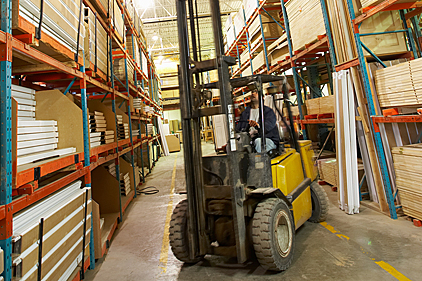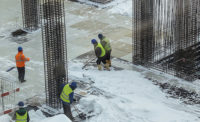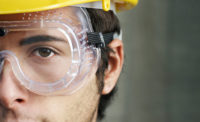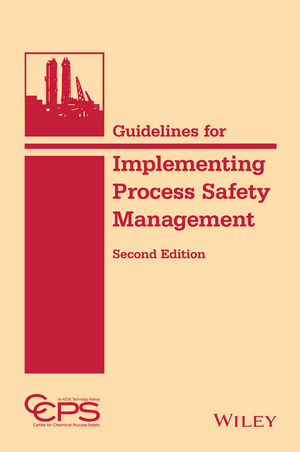OSHA guidelines for keeping workers safely on their feet

OSHA says that employers must set up the workplace to prevent employees from falling off of overhead platforms, elevated workstations or into holes in the floor and walls. On OSHA’s Safety & Health Topics, Fall Protection page, the agency outlines its guidelines for providing fall protection on the job.
What can be done to reduce falls?
OSHA requires that fall protection be provided at elevations of four feet in general industry workplaces, five feet in shipyards, six feet in the construction industry and eight feet in longshoring operations. In addition, OSHA requires that fall protection be provided when working over dangerous equipment and machinery, regardless of the fall distance.
To prevent employees from being injured from falls, employers must:
- Guard every floor hole into which a worker can accidentally walk (using a railing and toe-board or a floor hole cover).
- Provide a guard rail and toe-board around every elevated, open-sided platform, floor or runway.
- Regardless of height, if a worker can fall into or onto dangerous machines or equipment (such as a vat or acid or a conveyor belt), employers must provide guardrails and toe-boards to prevent workers from falling and getting injured.
- Other means of fall protection that may be required on certain jobs include safety and harness and line, safety nets, stair railings and hand rails.
OSHA requires employers to:
- Provide working conditions that are free of known dangers.
- Keep floors in work areas in a clean and, so far as possible, a dry condition.
- Select and provide required personal protective equipment at no cost to workers.
- Train workers about job hazards in a language that they can understand.
How to protect workers from falls
There are a number of ways employers can protect workers from falls, including through the use of conventional means such as guardrail systems, safety net systems and personal fall protection systems, the adoption of safe work practices, and the provision of appropriate training. The use of warning lines, designated areas, control zones and similar systems are permitted by OSHA in some situations and can provide protection by limiting the number of workers exposed.
Whether conducting a hazard assessment or developing a comprehensive fall protection plan, thinking about fall hazards before the work begins will help the employer to manage fall hazards and focus attention on prevention efforts. If personal fall protection systems are used, particular attention should be given to identifying attachment points and to ensuring that employees know how to properly use and inspect the equipment. For a list of references that aid in recognizing and evaluating fall protection hazards in the workplace, visit www.osha.gov/SLTC/fallprotection/evaluation.html.
Fall protection equipment
All fall protection products fit into four functional categories. 1. Fall Arrest; 2. Positioning; 3. Suspension; 4. Retrieval. OSHA offers the following descriptions of each category:
Fall arrest
A fall arrest system is required if any risk exists that a worker may fall from an elevated position, as a general rule, the fall arrest system should be used anytime a working height of six feet or more is reached. Working height is the distance from the walking/working surface to a grade or lower level. A fall arrest system will only come into service should a fall occur. A full-body harness with a shock-absorbing lanyard or a retractable lifeline is the only product recommended. A full-body harness distributes the forces throughout the body, and the shock-absorbing lanyard decreases the total fall arresting forces.
Positioning
This system holds the worker in place while keeping his/her hands free to work. Whenever the worker leans back, the system is activated. However, the personal positioning system is not specifically designed for fall arrest purposes.
Suspension
This equipment lowers and supports the worker while allowing a hands-free work environment, and is widely used in window washing and painting industries. This suspension system components are not designed to arrest a free fall, a backup fall arrest system should be used in conjunction with the suspension system.
Retrieval
Preplanning for retrieval in the event of a fall should be taken into consideration when developing a proactive fall management program.
Fall Protection Systems
Listed below are different types of fall safety equipment and their recommended usage.
|
Class 1 |
Body belts (single or double D-ring) are designed to restrain a person in a hazardous work position and to reduce the possibility of falls. They should not be used when fall potential exists; positioning only. |
|
Class 2 |
Chest harnesses are used when there are only limited fall hazards (no vertical free fall hazard), or for retrieving persons such as removal of persons from a tank or a bin. |
|
Class 3 |
Full body harnesses are designed to arrest the most severe free falls. |
|
Class 4 |
Suspension belts are independent work supports used to suspend a worker, such as boatswain's chairs or raising or lowering harnesses. |
|
Rope Lanyard |
Offers some elastic properties for all arrest; used for restraint purpose. |
|
Web Lanyard |
Ideal for restraint purposes where fall hazards are less than 2 feet. |
|
Cable Positioning |
Designed for corrosive or excess heat environments and must be used in conjunction with shock absorbing devices. |
|
Shock Absorbers |
When used, the fall arresting force will be greatly reduced if a fall occurs. |
|
Rope Grabs |
A deceleration device which travels on a lifeline, used to safely ascend or descend ladders or sloped surfaces and automatically, by friction, engages the lifeline and locks so as to arrest the fall of an employee. |
|
Retractable Lifeline Systems |
Gives fall protection and mobility to the user when working at height or in areas where there is a danger of falling. |
|
Safety Nets |
Can be used to lesson the fall exposure when working where temporary floors and scaffolds are not used and the fall distance exceeds 25 feet. |
|
Rail Systems |
When climbing a ladder, rail systems can be used on any fixed ladder as well as curved surfaces as a reliable method of fall prevention. |
Effective January 1, 1998, body belts are not acceptable as part of a personal fall arrest system. (Note: the use of a body belt in a positioning device system is acceptable and is regulated under paragraph (e) of 29 CFR 1926.502). An employee who uses a body belt as a personal fall arrest system is exposed to hazards such as falling out of the belt, serious internal injuries, and technical asphyxiation through prolonged suspension.
Looking for a reprint of this article?
From high-res PDFs to custom plaques, order your copy today!










